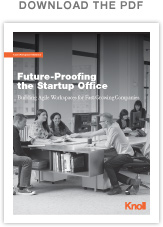
The Startup State of Mind
“All you need is an idea and an Internet connection.” That quick remark from a technology startup founder distills a generational shift in today’s business environment, where billion dollar brands are being built in vastly different ways from the offices and factories of years past.
This is the domain of the 21st century startup, a label liberally applied to the ventures created by tech-savvy, industry-disrupting, rule-breaking visionaries and employees. What was once a noun to describe a purely technology business, startup has taken on a broader definition for a breed of lean, collaborative, and agile companies. ‘Startup’ is not a measure of a business — it’s a business state of mind.
Courtesy of technology, today’s startups achieve great feats with speed unlike any time before. Yet for all their intensity, velocity, and digitally unshackled freedom, these companies still face the challenge of creating high-performing, adaptable work environments that enable productivity critical to navigating unpredictable growth on their road to commercial viability.
Startup workplaces, often pieced together under hectic circumstances and short time frames, frequently lack the flexible, modular, and organizational solutions that allow the uninterrupted productivity they require to flourish.
So, how do startups future-proof their environments in a business climate that may jump from four founders to 20 employees in one year and explode to a team of 75 a year later?
To capture the best practices of growing startup office environments, we spoke to a diverse set of stakeholders including founders, employees, facilities planners, operations directors, venture capitalists, architects, designers, and real estate professionals.
The Startup Office Environment
For startups, there is a great deal of friction in creating physical environments along the journey and quest for greatness.
While initial founders can handle the coffee shop as the conference room or the corner of another office as home base, the functional and cultural requirements of an office quickly become a reality as a team grows in size.
Ignoring that reality may not doom a business, but it creates an avoidable drag on the overall mission of the company. Why? A well-performing environment is crucial in the high-stress, fastpaced crucible of a startup. There is a return on investment for the environment, just as state-of-the-art laptops and smartphones deliver a return to the business in terms of output.
At its core, the environment’s job is to quietly enable the success of a startup by letting high-performance happen — particularly in an organization that is constantly pushing itself to new peaks of success. The environment is critical in several areas:
-
Stimulating productivity
-
Providing a sense of stability
-
Fostering collaboration
-
Reinforcing transparency
-
Cultivating a sense of culture, identity and spirit
-
Evoking a ‘second home’ feeling
-
Supporting talent acquisition and employee retention
For companies that have scaled successfully, the physical environment is rarely a perfect journey. But there are important lessons to be gleaned for new startups to ensure the environment performs today and avoids pitfalls tomorrow.
Key Findings
Key observations of startups and their physical environment include:
1. Early stage startups just make do
When there are only a few employees and the business is finding its marketplace niche, the physical environment matters less.
. The mid-stage of a startup harbors themost friction
A great deal of friction is experienced between 30 and 74 employees. Offices must transition from bootstrapped operations to well-oiled organizations. Growth creates spatial squeezing and multiple office moves often occur.
3. Flexibility is fleeting
Even when startups prepare two steps ahead, they often arrive there in what feels like a single leap. While aiming to have reconfigurable furniture and spaces, more often than not, fast growth forces major sacrifices of critical functional spaces (e.g., collaboration spaces).
4. Many startup offices are short on the variety of spaces needed to accommodate the multiple types of work
Beyond individual work areas, companies need to delineate a mix of breakout meeting spaces, private spaces, and soft spaces to accommodate the different activities that keep a team at peak productivity.
5. Planning for technology and data is often overlooked
When creating an open plan desk layout, data and power cables can be a costly imposition when not thoughtfully planned.
6. The notion that the environment can maximize team performance is well understood
People are the most significant investment of an early business and their productivity is the lifeblood of the organization.
DOWNLOAD "Future-Proofing the Startup Office" TO READ THE FULL PAPER



















